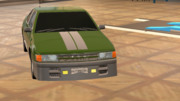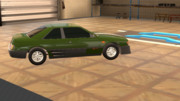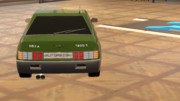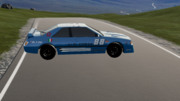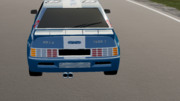The history of these cars are amazing, great job
In 1963 the F.S.A. began to expand its establishment in view of the production of the “Aetna” model.
In 1965 the sedan and coupe versions of the “Aetna” were presented at the Turin Motor Show, which were available in two versions, Premium with a 1600cc engine and Standard with a 1300cc engine, which differed in chrome and the number of front lights.
The sedan version
Aetna 1600
Chassis Galvanized Steel monocoque and steel panels
Drivetrain Rear longitudinal RWD
Gearbox 4 manual
Suspension Double Wishbone (front and rear) with progressive springs
Brake solid disc (Front and rear)
Driver aids Hydraulic power steering
Motor four 1598cc inline cylinders DOHC with 2 Barrel carburetor that produced 92 hp at 5900 rpm and 130 Nm at 4000 rpm.
Interior
4 premium seats whit AM radio.
Performance
Top speed 158 Km / h
0-100 12.1 sec.
Power to Weight 0.058
the car files
Aetna - 1600.car (33.6 KB)
Aetna 1300
Chassis Galvanized Steel monocoque and steel panels
Drivetrain Rear longitudinal RWD
Gearbox 4 manual
Suspension Double Wishbone (front and rear) with progressive springs
Brake solid disc (Front and rear)
Driver aids Hydraulic power steering
Motor four 1290cc inline cylinders DOHC with Twin carburetor that produced 73 hp at 5900 rpm and 105 Nm at 3600 rpm.
Interior
4 standard seats whit AM radio.
Performance
Top speed 146 Km / h
0-100 14.5 sec.
Power to Weight 0.047
the car files
Aetna - 1300.car (32.8 KB)
The Aetna 1600 was produced in 130,000 units and the Aetna 1300 in 144.213 units for a total of 274.213 units of the sedan version produced from 1965 to 1972.
(continued with the coupe version …)
Aetna 1.6 SS
Chassis Galvanized Steel monocoque and steel panels
Drivetrain Rear longitudinal RWD
Gearbox 4 manual
Suspension Double Wishbone (front and rear)
Brake solid disc (Front and rear)
Motor four 1598cc inline cylinders DOHC with Twin DCOE carburetor that produced 105 hp at 5900 rpm and 138 Nm at 4000 rpm.
Interior
2 premium seats whit AM radio.
Performance
Top speed 158 Km / h
0-100 11.3 sec.
Power to Weight 0.071
the car files
Aetna - 1.6 SS.car (32.1 KB)
Aetna 1.3 SS
Chassis Galvanized Steel monocoque and steel panels
Drivetrain Rear longitudinal RWD
Gearbox 4 manual
Suspension Double Wishbone (front and rear)
Brake solid disc (Front and rear)
Motor four 1290cc inline cylinders DOHC with Twin DCOE carburetor that produced 88 hp at 6000 rpm and 114 Nm at 4000 rpm.
Interior
2 standard seats whit AM radio.
Performance
Top speed 146 Km / h
Performance
Top speed 147 Km / h
0-100 12.7 sec.
Power to Weight 0.061
the car files
Aetna - 1.3 SS.car (32.7 KB)
The Aetna 1.6 SS was produced in 42,000 units and the Aetna 1.3 SS in 63,000 units for a total of 105,000 units of the coupè version produced from 1965 to 1972.
(continued with the version of Aetna 1600 for Group 2 GT races)
In 1966 the racing division of F.S.A. designed and built the Aetna 1600 GTI model, I for injection, in the 500 units required for the approval in group 2 of these 150 were reworked to participate in the GT Championships.
The road version
Chassis Galvanized Steel monocoque and steel panels
Drivetrain Rear longitudinal RWD
Gearbox 4 manual
Suspension Double Wishbone (front and rear)
Brake solid disc (Front and rear)
Motor four 1598cc inline cylinders DOHC with Mechanical injection that produced 116 hp at 6000 rpm and 144 Nm at 4500 rpm.
Interior
2 basic seats whit AM radio.
Performance
Top speed 167 Km / h
0-100 9.90 sec.
Power to Weight 0.081
the car files
Aetna - 1600 GTI (Road Version).car (36.7 KB)
The group 2 race reworked
(in the photos the car of german driver H. Kehl in the livery of the Federal German flag to celebrate the title of the 1967 European GT championship.)
Chassis Galvanized Steel monocoque and steel panels
Drivetrain Rear longitudinal RWD
Gearbox 4 manual
Suspension Double Wishbone (front and rear)
Brake solid disc (Front and rear)
Motor four 1598cc inline cylinders DOHC with Mechanical injection that produced 144 hp at 7000 rpm and 153 Nm at 6300 rpm.
Interior
2 sport seats.
Performance
Top speed 179 Km / h
0-100 8.70 sec.
Power to Weight 0.102
the car files
Aetna - 1600 GTI (Group 2).car (41.4 KB)
In 1965 the president of the F.S.A. he decided to make the funds available to create an official racing team that ran in the Sport Prototypes world championship with the aim of managing a prototype car with a 2000cc V8 engine.
After two years of intense technical and logistic study, the prototype Sikelia SP 2.0 car was born, which was produced in two copies and which ran in the 1967 and 1968 seasons; winning the title in the Prototype category up to 2000cc in the 1968 year.
Chassis Steel monocoque and fibre glass panels
Drivetrain Middle longitudinal RWD
Gearbox 5 manual
Suspension Double Wishbone (front and rear)
Brake solid disc with 2 pistons (Front and rear)
Motor V8 (90) 1997cc DOHC 4 valve per cylinder with Mechanical injection and race intake that produced 232 hp at 8100 rpm and 217 Nm at 7100 rpm.
Interior
2 sport seats.
Performance
Top speed 208 Km / h
0-100 5.95 sec.
Power to Weight 0.163
the car files
Sikelia - SP 2.0.car (44.8 KB)
In 1969 the F.A.X. , trying to exploit the advertising derived from the victories of the Sikelia SP 2.0, put on the market a pony car that had as engine the two-liter V8, suitably reworked for road and used on the prototype of F.S.A., which was called Recife.
The Recife had the peculiarity of mounting the motor in the middle position which made it a mix between a European sports car and an American muscle car.
Chassis Galvanized Steel monocoque and Steel panels
Drivetrain Middle longitudinal RWD
Gearbox 5 manual
Suspension Double Wishbone (front and rear)
Brake solid disc with 1 piston (Front) solid disc 2 pistons ( rear)
Motor V8 (90) 1997cc DOHC with Mechanical injection and race intake that produced 180 hp at 6700 rpm and 200 Nm at 5700 rpm.
Interior
2 luxury seats with AM/FM Radio.
Performance
Top speed 204 Km / h
0-100 7.62 sec.
Power to Weight 0.106
the car files
FAX - Recife.car (34.5 KB)
Recife was sold from 1969 to 1972 in 8,722 units of which 3,722 were sold in the USA.
The end of the 60s is a very important period for the F.S.A. because, taking advantage of the state aid for the development of southern Italy, a second plant is opened where starting from 1971 the Jonia model will be produced (coming soon …) but also because the official team of the house, the Sikelia Corse, given the excellent results of the Sikelia Prototype with 2000cc engine, he decided to install the new 3000cc engine on the same chassis and deeply revise the aerodynamics with the installation of a wing and new air intakes.
Chassis Steel monocoque and fibre glass panels
Drivetrain Middle longitudinal RWD
Gearbox 5 manual
Suspension Double Wishbone (front and rear)
Brake solid disc with 2 pistons (Front and rear)
Motor V8 (90) 2997cc DOHC 4 valve per cylinder with Mechanical injection and race intake that produced 424 hp at 9000 rpm and 360 Nm at 7300 rpm.
Interior
2 sport seats.
Performance
Top speed 255 Km / h
0-100 4.40 sec.
Power to Weight 0.276
the car files
Sikelia - SP 3.0.car (48.0 KB)
The Sikelia SP 3.0 ran in the seasons from 1969 to 1972 and despite the overwhelming power of the Parshe, the Olpine Ranault and the Ferrori managed to win three absolute victories, namely the Targa Florio, 1000 km of Brands Hatch and 6h of watkins Glen.
In 1971 from the new factory of F.S.A. , opened near Catania, the first batch of the Jonia 1200 model was released, which became the basic model of the range of cars produced by F.S.A …
The Jonia 1200 was special because it was the first hatchback with FWD produced by the car manufacturer.
Chassis Galvanized Steel monocoque and Corrosion res. Steel panels
Drivetrain Front longitudinal FWD
Gearbox 4 manual
SuspensionMac Pherson(Front) Semi trailing arm (Rear)
Brake solid disc with 1 piston (Front) Drum SLS ( rear)
Motor Boxer 4 cyl. 1188cc SOHC with 2 barrel carburetor that produced 61 hp at 5400 rpm and 94 Nm at 2900 rpm.
Interior
4 basic seats with AM/FM Radio.
Performance
Top speed 147 Km / h
0-100 15.1 sec.
Power to Weight 0.046
the car files
Jonia - 1200.car (34.5 KB)
in 1975 to fight the competition it was decided to increase the performance with the introduction of the Jonia 1300 model that had the 1351cc engine but the petrol consumption remained unchanged compared to the previous model also there was a restyling with the introduction of the first finishings in plastic.
Chassis Galvanized Steel monocoque and Corrosion res. Steel panels
Drivetrain Front longitudinal FWD
Gearbox 4 manual
SuspensionMac Pherson(Front) Semi trailing arm (Rear)
Brake solid disc with 1 piston (Front) Drum SLS ( rear)
Motor Boxer 4 cyl. 1351cc SOHC with 2 barrel carburetor that produced 70 hp at 5500 rpm and 106 Nm at 3200 rpm.
Interior
4 basic seats with AM/FM Radio.
Performance
Top speed 151 Km / h
0-100 13.5 sec.
Power to Weight 0.052
the car files
Jonia - 1300.car (35.9 KB)
In addition, in 1975 the Jonia 1300 Cup model was built by the sports department which served as the base car for a single-make championship that was so successful that it also had a European title.
Chassis Galvanized Steel monocoque and Corrosion res. Steel panels
Drivetrain Front longitudinal FWD
Gearbox 4 manual
SuspensionMac Pherson(Front) Semi trailing arm (Rear)
Brake solid disc with 1 piston (Front) Drum SLS ( rear)
Motor Boxer 4 cyl. 1351cc SOHC with mechanical injection that produced 90 hp at 5900 rpm and 122 Nm at 3900 rpm.
Interior
2 sport seats.
Performance
Top speed 164 Km / h
0-100 10.1 sec.
Power to Weight 0.072
the car files
Jonia - 1300 CUP.car (37.1 KB)
production of the Jonia model ended in 1981 after 1,200,000 cars produced.
n 1970 the F.S.A. presented the new Sedan which was called “Salina” and which was available in the 1600 and 1800 versions.
The novelty of the model was the application of the engine in a transverse position and the front wheel drive.
Salina 1600
Chassis Galvanized Steel monocoque and Corrosion res. Steel panels
Drivetrain Front Transverse FWD
Gearbox 5 manual
Suspension Double wishbone(Front) Semi trailing arm (Rear)
Brake solid disc (Front and rear)
Motor In line 4 cyl. 1588cc DOHC with mechanical injection that produced 101 hp at 6000 rpm and 134 Nm at 4000 rpm.
Interior
4 standard seats with AM Radio
Performance
Top speed 168 Km / h
0-100 11.9 sec.
Power to Weight 0.058
Salina 1800
Chassis Galvanized Steel monocoque and Corrosion res. Steel panels
Drivetrain Front Transverse FWD
Gearbox 5 manual
Suspension Double wishbone(Front) Semi trailing arm (Rear)
Brake solid disc (Front and rear)
Motor In line 4 cyl. 1779cc DOHC with mechanical injection that produced 105 hp at 5400 rpm and 145 Nm at 4500 rpm.
Interior
4 premium seats with AM/FM Radio
Performance
Top speed 172 Km / h
0-100 12.1 sec.
Power to Weight 0.058
In 1975 the “Salina” underwent a restyling with the introduction of the first plastic details and the debut of the 2000 version, which replaced at the top of the range the 1800, which had square front headlights.
Salina 1800 (MY 1975)
Chassis Galvanized Steel monocoque and Corrosion res. Steel panels
Drivetrain Front Transverse FWD
Gearbox 5 manual
Suspension Double wishbone(Front) Semi trailing arm (Rear)
Brake solid disc (Front and rear)
Motor In line 4 cyl. 1779cc DOHC with mechanical injection that produced 105 hp at 5400 rpm and 145 Nm at 4500 rpm.
Interior
4 standard seats with AM/FM Radio
Performance
Top speed 172 Km / h
0-100 11.5 sec.
Power to Weight 0.061
Salina 2000
Chassis Galvanized Steel monocoque and Corrosion res. Steel panels
Drivetrain Front Transverse FWD
Gearbox 5 manual
Suspension Double wishbone(Front) Semi trailing arm (Rear)
Brake solid disc (Front and rear)
Motor In line 4 cyl. 1961cc DOHC with mechanical injection that produced 108 hp at 5500 rpm and 159 Nm at 4000 rpm.
Interior
4 Premium seats with Premium 8 track
Performance
Top speed 174 Km / h
0-100 10.9 sec.
Power to Weight 0.060
The “Salina” was sold in 476,000 units from 1970 to 1980.
The Cars Files
Salina - 1600 .car (34.8 KB)
Salina - 1800.car (34.3 KB)
Salina - 1800 (MY 75).car (34.8 KB)
Salina - 2000.car (34.3 KB)
In 1973 the F.A.X. he built the “Bahia 2300” model which was nothing more than a version powered by the 2300cc engine with the addition of a chrome band on the side of the “Salina”.
Bahia 2300
Chassis Galvanized Steel monocoque and Corrosion res. Steel panels
Drivetrain Front Transverse FWD
Gearbox 5 manual
Suspension Double wishbone(Front) Semi trailing arm (Rear)
Brake solid disc (Front and rear)
Motor In line 4 cyl. 2311cc DOHC with mechanical injection that produced 130 hp at 5500 rpm and 185 Nm at 4000 rpm.
Interior
4 Premium seats with AM/FM radio
Performance
Top speed 186 Km / h
0-100 9.66 sec.
Power to Weight 0.071
The car files
Salina - FAX Bahia 2300.car (37.4 KB)
The “Bahia 2300” was produced until 1981 when the F.S.A. sold the plant to the Brazilian government.
in 1974 the F.S.A. presented the model Mozia which was the premium coupé that flanked the Salina sedan in the range.
Chassis Galvanized Steel monocoque and aluminium panels
Drivetrain Front Transverse FWD
Gearbox 5 manual
Suspension Double wishbone(Front and Rear)
Brake solid disc (Front ) Drum (rear)
Motor In line 4 cyl. 1999cc DOHC with mechanical injection that produced 114 hp at 5500 rpm and 167 Nm at 3800 rpm.
Interior
2 Premium seats with 8 track premium
Performance
Top speed 171 Km / h
0-100 7.99 sec.
Power to Weight 0.088
In 1975 the Mozia was reworked by the sports department of the F.S.A. to return to group 2 and participate in the ETCC.
Chassis Galvanized Steel monocoque and aluminium panels
Drivetrain Front Transverse FWD
Gearbox 5 manual
Suspension Double wishbone(Front and Rear)
Brake solid disc (Front ) Drum (rear)
Motor In line 4 cyl. 1999cc DOHC with mechanical injection that produced 151 hp at 6000 rpm and 183 Nm at 5800 rpm.
Interior
2 sport seats
Performance
Top speed 167 Km / h
0-100 7.14 sec.
Power to Weight 0.132
Also in 1979 a small series was built, 400 units, of Mozia equipped with a turbo engine that served to homologate the car in Group 4
Chassis Galvanized Steel monocoque and aluminium panels
Drivetrain Front Transverse FWD
Gearbox 5 manual
Suspension Double wishbone(Front and Rear)
Brake solid disc (Front ) Drum (rear)
Motor In line 4 cyl. 1962cc DOHC turbo with mechanical injection that produced 175 hp at 6000 rpm and 229 Nm at 3700 rpm.
Interior
2 sport seats
Performance
Top speed 198 Km / h
0-100 5.82 sec.
Power to Weight 0.153
The Mozia WRC participated in the world rally in the 1980s and 1981.
Chassis Galvanized Steel monocoque and aluminium panels
Drivetrain Front Transverse FWD
Gearbox 5 manual
Suspension Double wishbone(Front and Rear)
Brake solid disc (Front ) Drum (rear)
Motor In line 4 cyl. 1962cc DOHC turbo with mechanical injection that produced 373 hp at 7300 rpm and 372 Nm at 6800 rpm.
Interior
2 sport seats
Performance
Top speed 155 Km / h
0-100 5.95 sec.
Power to Weight 0.313
In 1980 the F.S.A., to meet the demands of the North European customers not bound by the taxes present in Italy for the displacements exceeding 2000cc, presented the Mozia 2500 C a premium coupé with two seats and that fitted a 2500cc V6 engine.
The Mozia 2500 C was sold in 22,000 units from 1980 to 1984.
Chassis Galvanized Steel monocoque and aluminium panels
Drivetrain Front Transverse FWD
Gearbox 5 manual
Suspension Double wishbone(Front and Rear)
Brake solid disc (Front ) Drum (rear)
Motor V 6 cyl. 2492cc SOHC with mechanical injection that produced 156 hp at 5600 rpm and 205 Nm at 4600 rpm.
Interior
2 Premium seats with 8 track premium
Performance
Top speed 184 Km / h
0-100 7.03 sec.
Power to Weight 0.120
In 1982 the Mozia 2500 CA was presented, the sports version destined for Group A races in which it ran from 1982 to 1986 winning the ETCC in the period 83-84.
Chassis Galvanized Steel monocoque and aluminium panels
Drivetrain Front Transverse FWD
Gearbox 5 manual
Suspension Double wishbone(Front and Rear)
Brake solid disc (Front ) Drum (rear)
Motor V 6 cyl. 2492cc SOHC with mechanical injection that produced 214 hp at 6500 rpm and 245 Nm at 5700 rpm.
Interior
2 sport seats
Performance
Top speed 204 Km / h
0-100 5.59 sec.
Power to Weight 0.176
Must have been a challenge to setup the suspension for Mozia 2500. FWD and a big V6 in the front, short wheelbase - it says massive understeer tendency. It’s like an Alfasud with a Busso V6 squeezed into its nose. I like it. 
In 1981 the F.S.A. presented the “Fuoco” model a sports car born to be produced in 200 units, to homologate it in Group B and participate in the WRC, but that thanks to the combination of performance and low consumption (24.6 UK mpg) was produced in 600 units.
The WRC version ran in the 1982-83 seasons with decent results but never managed to win due to the overwhelming power of Audi and Lancia
The “Fuoco” 2000 technical fiches
Chassis Corrosion Res. Steel monocoque and Fibre Glass panels
Drivetrain Front Longitudinal RWD
Gearbox 5 manual
Suspension Double wishbone(Front and Rear)
Brake disc (Front and rear)
Motor I4 cyl. 1995cc DOHC with Turbo and mechanical injection that produced 183 hp at 6200 rpm and 233 Nm at 4700 rpm.
Interior
2 premium seats with premium 8 track radio.
Performance
Top speed 203 Km / h
0-100 6.78 sec.
Power to Weight 0.129
The “Fuoco” 2000 WRC technical fiches
Chassis Corrosion Res. Steel monocoque and Fibre Glass panels
Drivetrain Front Longitudinal RWD
Gearbox 5 manual
Suspension Double wishbone(Front and Rear)
Brake disc (Front and rear)
Motor I4 cyl. 1995cc DOHC with Turbo and mechanical injection that produced 300 hp at 7000 rpm and 325 Nm at 6200 rpm.
Interior
2 sport seats
Performance
Top speed 239 Km / h
0-100 6.66 sec.
Power to Weight 0.217
In the 80’s the FSA decided to expand its range of vehicles and produce the following models:
NICA, basic two hatchback doors
JONIA, standard two hatchback doors
HYBLA, premium and standard sedan four doors
ROSA, two-door premium coupe with the homologated version in the A3 group.
NICA
Trim 900 and 900 van
Products from 1980 to 1986 were equipped with a 965 cc SOHC I4 engine that produced 44 hp at 5200 RPM and 72 Nm at 2900 RPM
Nica - 900.car (30.3 KB)
Nica - 900 VAN.car (35.0 KB)
Trim 1000 and 1000 4x4
Body restyling that fitted the new 999 cc SOHC I4 engine that produced 46 hp at 5200 RPM and 75 Nm at 2700 RPM
produced from 1987 to 1993.
Nica - 1000.car (31.6 KB)
Nica - 1000 4x4.car (33.4 KB)
to be continued …
The second generation of the Jonia compared to the ancestor retains the Hatcback configuration but acquires a more squared design and becomes a three-door but maintains the standard quality interiors.
La Jonia was produced from 1980 to 1990 with a half-life makeover in 1985.
The Jonia was equipped with a 1500cc Boxer 4-cylinder engine with mechanical injection, since 1985 with EFI Single point, which produced 83 hp and from 121 to 125 Nm.
The main changes made to the 1985 variant were the introduction of progressive springs and a revision of the suspensions which led to an increase in practicality, comfort and load capacity.
Jonia had a great commercial success as a natural evolution for the owners of Nica waiting to gain access to the more expensive Hybla.
Jonia (2gen) - 1500 .car (32.0 KB)
Jonia (2gen) - 1500.car (29.3 KB)
In 1980 the F.S.A. presented the Hybla model at the Turin Motor Show, its new premium sedan that was equipped with a 1900cc engine with electronic fuel injection that produced 118 Hp.
Hybla was the first car of the company to mount the automatic transmission.
Hybla gained a good share of the market, particularly in the Premium Badget segment.
In 1986 the F.S.A. decided to produce the second series of Hybla which featured square headlights and new handles and, the first car in the history of the brand, had installed ABS but the real novelty was the adoption of the supercharged engine that produced 126 Hp.
Also this second series, produced until 1991, had a great sales success.
the 1 series, in gray, and the 2 series, in blue, of Hybla side by side in the photos.
Hybla - 1900 I.e.car (34.8 KB)
Hybla - 1800 Turbo.car (36.8 KB)
In 1985 the sports department of F.S.A. decided to design a new A3 group car to race in the Touring championships and for this purpose decided to design the 2 seats coupe called “Rosa” and produce the 6000 units needed for homologation.
The road version fitted the Hybla’s 1800cc turbo engine but modified to produce 156 hp.
In 1986 the racing version that saw the 1800cc turbo engine boosted to 274 hp was presented to the public.
in the picture the “Rosa” of the Alpi Corse team led by Franco Rol who won the Italian Touring Championship in 1987.
ROSA - 1800 T.car (32.0 KB)
ROSA - 1800 T Group A3.car (48.3 KB)
The racing department of F.S.A. decided, in conjunction with the change of regulation, to develop a version of the Jonia to race in the WRC and in rallies in general.
The car that was born had the appearance of the Jonia on the outside but fitted the 1.800cc turbo engine of the Rose developed for the road races of the group A and also the viscous LSD, the adaptive dampers and the AWD transmission will be installed.
The Jonia 1800 WRC behaved very well in the two-year period 1987-1988 and was second only to the Lancia Pelta in the world championship but in return it won the Italian Rally title in 1988.
In the picture the Sikania Corse car winner of the Italian rally champion in 1988.

















































































